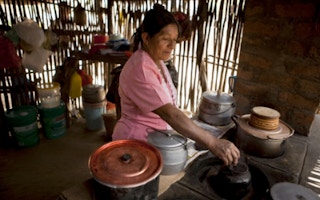The United Nations announced on Friday that it had issued its one billionth carbon credit to an Indian manufacturer under its much-debated clean development mechanism.
Indian building supply manufacturer Greenply Industries received the milestone UN-certified emission credit (CER) for its factory in Rajasthan, between Jaipur and New Delhi. The factory avoided 17,475 tonnes of greenhouse gas emissions annually by replacing coal and oil with renewable biomass as its fuel source under a project that was first registered with the UN in 2007.
Greenply buys the biomass – primarily mustard-husks, coconut shells and rice husks – from local farmers who transport the agricultural waste in camel carts.
The UN Framework Convention on Climate Change (UNFCCC) established the CDM under the 1997 Kyoto Protocol climate treaty to create financial incentives for companies to reduce greenhouse gas emissions and to promote clean technology transfer to developing countries.
Projects that qualify under the CDM receive CERs for the emissions they avoid, which they can then sell on carbon markets such as the European Union Emissions Trading System (EU-ETS). Each CER represents a reduction of one tonne of carbon dioxide (CO2) or its greenhouse gas equivalent.
UNFCCC chief Christiana Figueres said in a statement that the milestone was a testament to the expanding use of the CDM.
“The CDM is not only having an important impact on developing countries through technology transfer and sustainable development, but it can also encourage developed countries to increase their emission reduction targets by making mitigation more affordable,” she added.
Nearly 40 developed countries agreed to legally binding CO2 reduction targets under phase one of the Kyoto Protocol, which expires at the end of this year. Climate negotiators have failed to come up with a replacement agreement, but have set a 2015 deadline to design a new pact to take effect in 2020.
Countries that fall short of CO2 reduction targets have been purchasing the UN carbon credits generated by more than 4,500 CDM projects in 75 countries to offset their emissions, as have companies seeking to meet either voluntary or mandatory carbon emissions targets.
Chair of the CDM board Maosheng Duan said that the CDM had seen significant improvements in recent years, including streamlining the registration process and making the scheme friendlier for small-scale projects such as solar water heaters and cleaner cooking stoves.
“Huge strides have already been made in these areas and the Board will continue its efforts to improve the CDM to make it increasingly attractive to the current and many emerging emissions trading systems,” he noted.
CDM under scrutiny
But despite the CDM reforms, some critics say the scheme falls short of its sustainable development goals.
Communications manager for Nexus-Carbon for Development Marion Santini told Eco-Business in an interview that, even with the reforms, managers of well-designed projects still find it difficult to get funding.
The network of non-governmental organizations, which aims to ensure that carbon financing for clean technology (cleantech) reaches the world’s poor, says that the most effective projects for helping poor populations - such as clean-burning cookstoves and small-scale biogas digesters for farmers - are more complex than conventional CDM projects.
Ms Santini said the projects needed longer planning times and more upfront funding to register on the CDM because - unlike a single factory or power plant - they can involve hundreds of thousands of households and pollution sources.
The CDM reforms meant to promote such cleantech projects have, in fact, created a perverse incentive to rapidly distribute products and collect the saleable CERs without regard for the long-term social development benefits, she noted.
“The risk is an increase in the number of projects that use the CDM to ‘mass dump’ units as quickly as possible to recover the high upfront costs and generate substantial financial returns.
“At best these interventions fail after a few years. Worst case scenario, they flood local markets with inappropriate technologies and undermine years of efforts by development practitioners working on strengthening local supply chains,” she added.
Despite its faults, the CDM has a key role in supporting both emissions reductions and sustainable development, noted Ms Santini.
“The CDM represents a much needed funding opportunity for low carbon development projects that have potential to bring numerous economic, social and environmental benefits to populations,” she said.
Other critics of the CDM, including several Indian companies that are hoping to turn to a domestic renewable energy credit (REC) system instead, have said that the UN process is too costly and can take years to produce financial returns.
Meanwhile, scandals have caused environmentalists to question the integrity of UN-backed carbon credits in several cases.
For example, last year the discovery of stolen credits in the EU-ETS led to a one-week trade hiatus to strengthen security. And several carbon exchanges, including the EU-ETS and New Zealand’s exchange, have banned CERs for projects that destroy a refrigerant by-product known as HFC-23 because several manufacturers were producing extra gas so that they could claim lucrative carbon credits for its destruction.
Group chief executive of clean energy company Sindicatum Sustainable Resources Assaad Razzouk acknowledged that the CDM’s integrity was much improved after the recent reforms, but noted that CDM credits are trading at all-time lows nonetheless.
“Today, we are operating in the ‘twilight zone’,” he noted, referring to uncertainty in global carbon policies and the flagging carbon markets that are meant to drive the CDM.
“We have a beautifully designed instrument which is valued at close to zero by the marketplace. If I owned the most beautiful car in the world, it would be very useful for its engine not to be missing,” he told Eco-Business.










